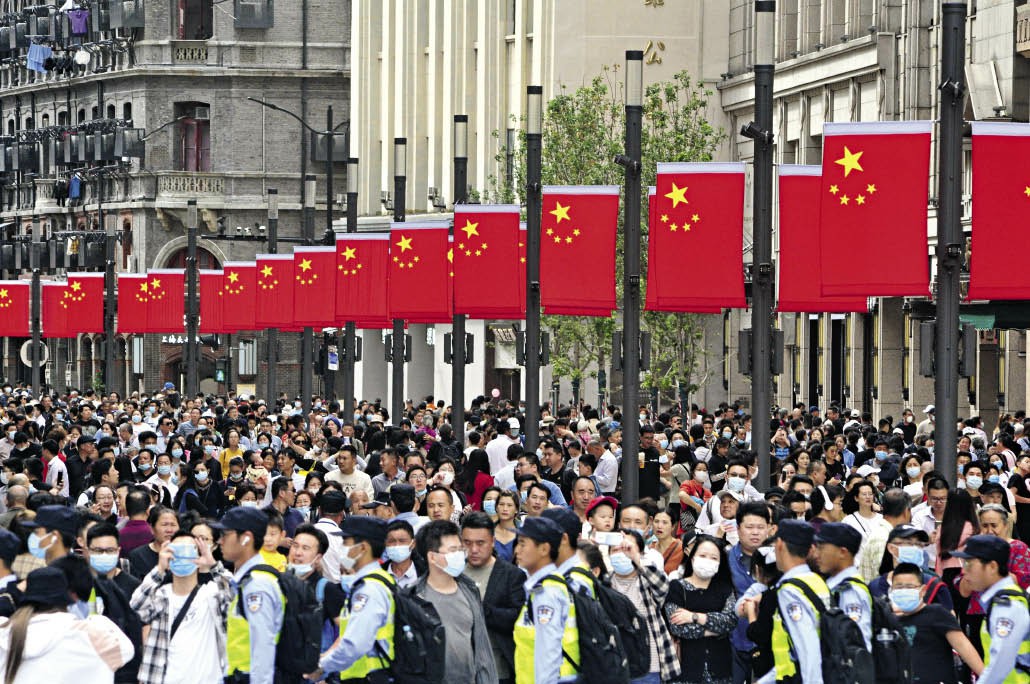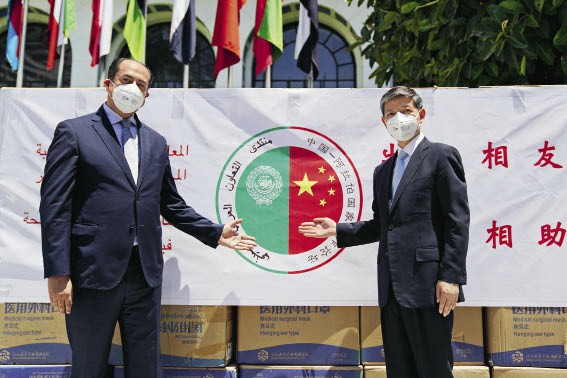THE COVID-19 pandemic has added more downward pressure to an already gloomy global economy. During the first quarter of this year, China’s GDP fell by 6.8 percent. Consumption demand, investment demand and export demand, which drive macroeconomic growth, all declined to varying degrees. Sectors specifically affected have been tourism, catering, and labor-intensive industries, while China’s economic development fluctuated in the short term.
Fortunately, the Chinese government made a series of wise decisions and coordinated all social sectors, and this, along with the solidarity of the Chinese people, helped the economy recover rapidly against adversity, making China a leader in global economic recovery.
A Strong Economic Foundation
China’s current economic development is rooted in the achievements made since the reform and opening-up policy was launched four decades ago. Thanks to the strong leadership of the Communist Party of China (CPC), with Xi Jinping at its core, and the solidarity and hard work of the Chinese people of all ethnic groups, China’s economic development remains stable despite the unexpected impact of COVID-19.
Since the outbreak of COVID-19, the Chinese government has coordinated epidemic prevention and control and economic and social development. It has introduced 90 policy measures in eight areas for targeted work and production resumption, and has stepped up macro-regulation.

The Nanjing Road Walkway in Shanghai is crowded on the sixth day of the National Day holiday on October 6, 2020.
As epidemic prevention and control becomes normality, China has begun to promote economic progress and a new philosophy of development. It puts supply-side structural reform at the core, and promotes high-quality development with reform and opening-up as the driving force. Furthermore, it works to ensure stability on six fronts — employment, basic living needs, operations of market entities, food and energy security, industrial and supply chains, and the normal functioning of primary-level governments.
China also firmly implements the strategy of expanding domestic demands. It has issued RMB one trillion special treasury bonds, and encourages the street economy. All these measures are aimed at maintaining economic development and social stability, in a bid to shake off poverty and build a moderately prosperous society in a holistic way.
After taking these various measures, the Chinese economy has stabilized. During the second quarter, major indicators of economy gradually picked up. The growth rate of GDP turned from negative to positive, reaching 3.2 percent. The value added of industries above designated size turned from declining to growing by 4.4 percent, and that of the service sector turned to growing by 1.9 percent. The decline in total retail sales of consumer goods narrowed by 15.1 percentage points compared with the first quarter. In June, China’s urban unemployment rate fell for the second month in a row to 5.7 percent.
During the first half of this year, China’s per capita transfer income increased by 8.2 percent in nominal terms, per capita pension and retirement benefits increased by 9.3 percent, and per capita income from social relief and subsidies increased by 13.2 percent. Emerging sectors gained momentum. The added value of manufacturing grew by 4.5 percent year on year, investment in hi-tech manufacturing by 5.8 percent, and investment in hi-tech services by 7.2 percent. Market expectations are generally positive.
In June, the Purchasing Managers’ Index (PMI) of China’s manufacturing industry was 50.9 percent, which has been above the critical point for four consecutive months, and the non-manufacturing business activity index was 54.4 percent, having been on the rise for four consecutive months. China’s economy is expected to keep growing, even though the global economy is expected to contract 5.2 percent this year, the World Bank said in its World Economic Outlook released on June 8, 2020.
Path to Recovery
The resilience of the Chinese economy shows that, based on the following four features, China’s economic recovery is on the way.
First, China has a complete market structure, with one of the largest consumer markets in the world and the fastest growing middle-income population group. China is also the only country with a complete set of industrial categories and the largest single market in the world, which enables it to be independent from foreign markets and yet meet domestic demands. To maintain normal life and production, China not only needs to take advantage of its system and industrial advantages, but also needs to “move” back the industrial chain and supply chain that are too independent on other countries. This will ensure the independent, normal operation of the domestic market.
Second, China’s status as a major outbound investor has not changed. Despite the impact of the epidemic, during the first half of 2020, Chinese investors made non-financial direct investment totaling RMB 362.14 billion (US $51.5 billion) in 159 countries and regions around the world. The sum going to the Belt and Road partner countries reached US $8.12 billion, up 19.4 percent year on year.
Third, the Belt and Road Initiative (BRI) is progressing steadily. China adheres to the principle of extensive consultation, joint contribution, and shared benefits, follows market principles and international rules, and allows the dominant role of enterprises to conduct mutually beneficial cooperation. At present, a large number of BRI cooperation projects that were temporarily suspended have been resumed, helping host countries to recover their economies. China will firmly uphold the multilateral trading system, strengthen economic and trade cooperation with other countries for mutual benefit and win-win results, open wider to the outside world, stabilize industrial and supply chains, and promote reform and development through further opening up.
Fourth, China is confident of achieving its economic development goals for 2020. China is skilled at giving full play to high economic added value, high return rates, and full utilization of resources. Based on hi-tech, it strives to achieve green and sustainable development and ecological progress. China is poised to win the battle against poverty, and work hard to build a moderately prosperous society in all respects and achieve the “Two Centenary Goals.”

On July 5, 2020, the Chinese ambassador to Egypt and also China’s representative to the League of Arab States (right) delivers supplies provided by the Chinese Foreign Ministry to the league secretariat and expresses the firm will of China and the Arab states to help each other in times of difficulty.
Further Opening and Cooperation
It is an indisputable fact that economic recovery, in the context of COVID-19, requires openness and cooperation. At present, the epidemic poses new challenges to security and development of all countries, and instability and uncertainty in the international situation have significantly increased. The biggest lesson drawn from the epidemic is that the lives, health, safety and interests of people of all countries are closely linked. Humanity is basically a community of shared future. China is ready to work with other countries to strengthen international cooperation on epidemic prevention and control, until the world finally overcomes the pandemic and a post-pandemic world featuring peace, stability, openness, diversity, and win-win cooperation comes into being.
Recently, some Western politicians have focused their voices on vilifying China and viciously attacking the Chinese political system. They stir up ideological antagonism, advocate Cold War mentality, and say that Western countries should jointly deal with the “China threat.” Such remarks, which run counter to the development and progress of the world, not only insult history and misread China, but also poison the atmosphere of international cooperation and harm the interests of all parties.
The zero-sum Cold War mentality, the concept that strong countries are bound to seek hegemony, and the Thucydides’s trap (the phenomena of a rising power and an established dominant power almost always breaking into conflict) are outdated in interpreting international relations. Ideological differences should not become an obstacle to peaceful coexistence and common development among countries. Dialogue is a wise choice to resolve differences, and cooperation is the best way to achieve win-win results.
China’s history and development are based on friendly cooperation and mutual benefit. It is the country that won freedom from imperialist and colonial oppression. Over the past 71 years since the founding of the People’s Republic of China, no matter how much the international landscape changed, China has always pursued an independent foreign policy of peace and been committed to developing friendly cooperation with other countries on the basis of the Five Principles of Peaceful Coexistence. China is committed to peaceful development and respects the right of people around the world to independently choose their own development path. China has no intention of institutional competition with other countries or exporting the “Chinese model” to any other country. China’s rapid development has benefited from exchanges and cooperation with other countries, and its continuous growth has in turn provided a driving force for sustained growth and a huge market space for all countries. China is willing to share its development opportunities with the whole world.
Although COVID-19 has hindered international exchanges, the trend of economic globalization and regional economic integration has not changed. The invisible hand is still playing a decisive role in the international allocation of resources. Countries continue to deepen division of labor and cooperation. The global governance philosophy of extensive consultation, joint contribution and shared benefits, as well as multilateralism have won the endorsement of an overwhelming number of countries.
During the first half of this year, China’s outbound direct investment reached US $47.2 billion, and foreign direct investment in China reached US $65.9 billion. During the first seven months of this year, 18,838 new foreign enterprises were set up in China. In addition, China remains committed to the basic state policy of reform and opening-up and the concept of people-centered development.
China’s economy rebounded in the second quarter, registering a 3.2 percent year-on-year GDP growth, setting the stage for continued growth during the second half of this year and even next year. The Chinese economy, which is building a new pattern of development, will continue to create new opportunities for common development of the world. International economic connectivity and exchanges remain an objective requirement for world economic development. Opening to the outside world remains China’s basic state policy. Even in the face of the epidemic, China remains committed to being a major economy that promotes mutual benefit and win-win outcomes through further opening up.
The negative list of access for foreign investment has been further shortened. The virtual roadshow of the China International Fair for Trade in Services (CIFTS) attracted thousands of enterprises from all over the world. Many exhibition areas at the upcoming third China International Import Expo (CIIE) are hard to find. China’s practical ideas and initiatives have demonstrated its determination to open up to the world, and these measures are crucial to world economic recovery.
Since the outbreak of COVID-19, China and Arab countries have supported each other in the fight against this epidemic and made firm progress in overcoming difficulties in economic cooperation, especially in the digital economy and other hi-tech fields. We are convinced that the cooperation between China and Arab countries, which has already laid a solid foundation, will move forward more firmly and yield more fruitful results in the post-pandemic era, which will not only benefit the two peoples, but also contribute to world economic recovery and prosperity.